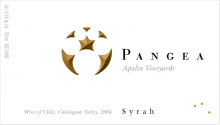Viña Ventisquero, Colchagua Valley--Apalta (Chile) 'Pangea' 2004 (Austral Wines, $50): I am a Syrah fan mainly in terms of the classic Syrah wines of the Northern Rhône, but I am  continually impressed with the quality of Syrah wines that I taste from regions that do not traditionally grow that grape. More than once I have wondered whether Syrah will become the new Cabernet Sauvignon--the grape that excels in some regions and also makes good wine just about everywhere.
continually impressed with the quality of Syrah wines that I taste from regions that do not traditionally grow that grape. More than once I have wondered whether Syrah will become the new Cabernet Sauvignon--the grape that excels in some regions and also makes good wine just about everywhere.
Of the wine producing countries not traditional for Syrah, Chile might prove to be one of the very best. It was only 14 years ago that French clones of Syrah came to Chile thanks to the Errazuriz winery, and only 11 years since the first Syrah vineyard was officially registered in the country. Syrah today accounts for less than three percent of Chile's wine grape plantings. And yet the wines can be impressive.
The newest entry on the Chilean Syrah market is a formidable one. Pangea is made at Viña Ventisquero by none other than John Duval, former Penfolds chief winemaker, together with Ventisquero's own talented winemaker Felipe Tosso. It is an elite Syrah, with only 1000 cases produced in 2004, its second vintage (2005 production is 1500 cases). Apalta, its region of production, is one of the finest in Chile for red wines.
Chile's elite Syrahs are big wines, and Pangea is no exception. It is full-bodied, dark in hue, and ripe. Although it is a powerful wine, it does not, however, trade only in power. Its oak frame gives it sleekness and its fine-grained tannin gives it soft, rich, velvety texture. Best of all, its flavors are complex. Many elite Syrahs from the New World are luxuriously fruity wines, but they have no flavor complexity apart from fruitiness. The 2004 Pangea instead has flavors that run along the Rhône-Syrah spectrum, including smoked bacon, peppery spice, chocolate, and a fleeting vegetal note along with black fruit and a lingering minerality on the finish. The fruit component is dominant on both the nose and palate--the dark plum becomes almost Port-like with lots of air--but the wine does not smell and taste only of fruit.
I prefer this 2004 Pangea to the 2005 because of its flavor complexity, but in all fairness the 2005 is a year behind in its development, and in fact I rate it equal in quality. The salient virtue of the 2005 is its seamlessness--a quality that exists as well in the 2004. And, of course, Australia's brilliant winemakers are renowned for crafting extraordinary soft tannins in their wines.
How long will 2004 Pangea age? It's anyone's guess, considering the lack of track record for this wine and for Chilean Syrahs in general. All of its components are in balance for aging, and its concentration of fruit character is certainly sufficient for, let's say, eight to ten years of development. But this wine is so smooth, so flavorful, and so delicious that it's tough to make a case for aging.
92 Points